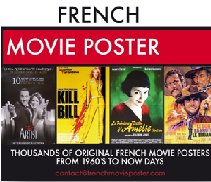Window cards were displayed in locations
OUTSIDE of the theatre. They were printed on a heavier, cheaper card stock.
They were placed in the windows of stores, barber shops. beauty salons,
doctor and dental offices, bakeries, on telephone poles, etc. in and around
a community. Since they were distributed in large numbers, theatres would
normally purchase them in bulk. Because so many more window cards were needed,
they were printed using a cheaper process. Thus, window cards lack the color,
detail and splendor of other sizes of movie art. This is particularly true
of the window cards produced by the independent printers.
There are three basic sizes of window
cards:
The artwork on the window cards released
by movie studios and/or the NSS may or may not be
the same as that of the one-sheet. They are normally
printed in full color, but lack the detail, color and artwork found on other
size posters. The standard window cards have a top blank border of approximately
4" to 6" inches. This border was used by the theatre to write in the dates
and show times of the featured film. Sometimes the theatres would staple
paper banners with the theatre's name in this blank area. Midget window
cards also have a border on the top. Jumbo window cards do not.
Click HERE
for Size Comparison
History
Secondary Printers
of Window Cards
Window Card As
a Collectable
HISTORY
Standard sized window cards were first
introduced in the 1910's, shortly after the one-sheet
and lobby cards. The earliest window cards were
produced in both the standard and the jumbo sizes. Midget window cards were
not introduced until the 1930�s.
Window cards were initially printed by
the movie studios and/or the National Screen Service ("NSS")
on cheap card stock, which made them more versatile than the paper materials.
Window cards were initially printed using
a brown-and-white rotogravure process. In
the 1920's, studios began producing their card stock materials through a
process known as photogelatin/collotype
or heliotype. This process initially offered one, than two, than three colors.
Window cards were designed as a "mass
advertising" tool. However, around 1984, advertising strategies changed
and window cards in all three sizes were phased out. Movie studios felt
they could better utilize mass advertising dollars in TV, radio and newspaper
advertising. In addition, theatres introduced the
mini sheet which is produced in larger numbers.
SECONDARY PRINTERS
OF WINDOW CARDS
In the 1940's, several independent printing
houses began releasing less expensive versions of the studio and/or NSS
-produced window cards. These cheaper alternatives were particular popular
with small city theatres and theatres located in rural areas. Because window
cards were purchased in bulk, the independently produced window cards were
much more cost effective for the theatres and film exchanges than were the
studio/NSS-produced versions.
The three main independent printing houses
known for their window cards were:
Benton Card Company
Globe Company
Hatch Show Prints.
The independent printers began producing
their version of the standard size window cards around the 1940's. Because
their main intent was to provide an even cheaper window card for use by
theatres and film exchanges, the window cards produced by these independent
printers were even more lackluster than the movie studio versions. Most
of the window cards were printed in either one, two or three colors. The
artwork was normally different from the studio/NSS-produced materials.
AS A COLLECTABLE
Because window cards were produced in
large quantities, they are not considered as valuable as other sizes of
posters. Within the category of window cards, there is a wide disparity
in the value of studio-produced window cards and those produced by independent
printers. Studio/NSS-produced window cards are considerably more collectible
than those that were independently produced. In fact, some collectors do
not even consider the independently-produced window cards to have any value
at all.
Window cards, particularly those produced
by the studios and/or the NSS, are popular with some collectors because
of their frameable size and because they are cheaper to obtain than other
materials from the same time period. Even independently-produced window
cards are considered collectible to some, as they may be the only opportunity
to acquire materials on a particular movie.
Window cards were normally shipped to
the theatre and/or film exhibitors flat. Since they were normally not originally
folded, window cards lose their value if they contain fold lines or creases.
Window cards also lose their value if the top blank border has been trimmed
off. Writing or other printing on the blank border of a window cards does
not affect its value as a collectible.
Card Chart





